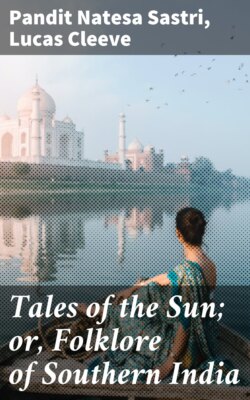Читать книгу Tales of the Sun; or, Folklore of Southern India - Pandit Natesa Sastri - Страница 3
На сайте Литреса книга снята с продажи.
ОглавлениеPreface.
Table of Contents
In offering these few Indian tales to the public, I cannot refrain from adding a few words at the beginning to express to Paṇḍit Natêśa Sástrî my gratitude for the great assistance he has given me in collecting them, assistance without which they would never have seen the light in the shape of a complete volume. When I began writing down these tales, my only means of collecting them was through my native servants, who used to get them from the old women in the bazaars; but the fables they brought me were as full of corruptions and foreign adaptions as the miscellaneous ingredients that find their way into a dish of their own curry and rice, and had it not been for Mr. Sástrî’s timely aid, my small work would have gone forth to the world laden with inaccuracies.
Mr. Sástrî not only corrected the errors of my own tales, but allowed me to add to them many that he had himself collected, and that had already been published, either in small volumes or in numbers of The Indian Antiquary. For this reason I have left several notes which Mr. Cowper Temple, Mr. Clowston, and others had added to the tales that had already been printed, as they were too valuable to dispense with, and may be of service to students of folklore. In conclusion, I would crave the indulgence of my readers with regard to the style in which the tales are written, which has been left as nearly as possible in the form of a literal translation, in order to lend the Stories a “couleur locale,” which is characteristic of the country they spring from.
G. K.
Introduction.
Table of Contents
It has often struck all lovers of Folklore and National Legends with wonder, that so many countries should have reproduced in different imagery and language the same tales. Persia, Arabia, and India give us the same fables as Italy, France, Norway, and Iceland, except for slight variations principally arising from difference of custom, distance of time, idiom and nationality.
Able writers have explained this to us by a theory worthy of consideration, and admirable in its origin, but nevertheless wholly their own. They would have us believe that a certain group of tales belonged to a certain nation, and that through emigration and immigration, through wars and dispersions, these same tales have been carried backwards and forwards and dragged from country to country borrowing the language and peculiarities of the lands they passed through, just as the seed of some rare plant is borne on the breeze and bears fruit coarse or more refined according to the soil in which it at last takes root.
In Germany we have Gödeck, Köhler, Sichecht, and a host of others who tell us that these tales are Oriental, and that all fable originates in the East, others again that they are transmitted to us by the same channel as the Aryan languages from Aryan tradition. I cannot see why one nation or one country alone should have the intelligence of producing fables which as a rule are next to religion in their teaching and intentions. If proverbs are the wisdom of nations, what are fables and legends but developed proverbs. What is the meaning of fable? It means an intent to convey moral instruction in a narrative in which the characters are represented by birds, beasts, or fishes; and often plants.
Practically a parable is the same thing, and folklore and fairy-tales are the attempts of intelligent people to inculcate in their children or other ignorant people the great truths of religion or wisdom, by means of word-pictures that would bring these truths within the easy grasp of undeveloped minds, it is the old repeated tale? The Struggle between Right and Wrong. “Faust and Marguerite.” The Wicked Punished, The Virtuous Rewarded.
Disguise them as you will, there are certain tendons which run through the world from age to age; cords which no human hand has yet severed—which no decree of God’s has changed—these are love and death, hate and vengeance, virtue and vice, right and wrong, suffering and joy; and as long as there is a world, as long as children are born, parents will invent fables with which to bring these facts before their offsprings’ eyes in an intelligible manner.
In the fables of the East, and especially of India, there is one peculiarity, namely, that craft and cunning are more generally rewarded than virtue, and stupidity condemned. This is the national characteristic. The tales of Southern India are as varied as any others, either Eastern or European. Magic and supernatural phenomena play a great part, but are usually assisted by the powers of the gods. This is again a national Hindoo characteristic. The Hindoo would shrink from any undertaking that is not under the patronage of the gods; yet here is a very noticeable feature, namely, that the divinities are treated as entirely secondary in power, interwoven only into a man’s daily affairs as a sort of backbone or support in time of need, but to be despised and trampled upon at other times with impunity. This is a natural feature in a nation which has a deity to represent every vice and sin, and lends a certain character to the tales of Southern India different to the folklore of other countries.
Probably further research will lay bare many still hidden treasures of Hindoo folklore; but this small collection of tales will doubtless suffice to throw light on Indian tradition, and to bring forward the natural peculiarities of the Hindoos as well as the assimilation of the folklore of different nations, an assimilation which I maintain results from the teaching propensities of each country and not from appropriation.
Georgiana Kingscote.
